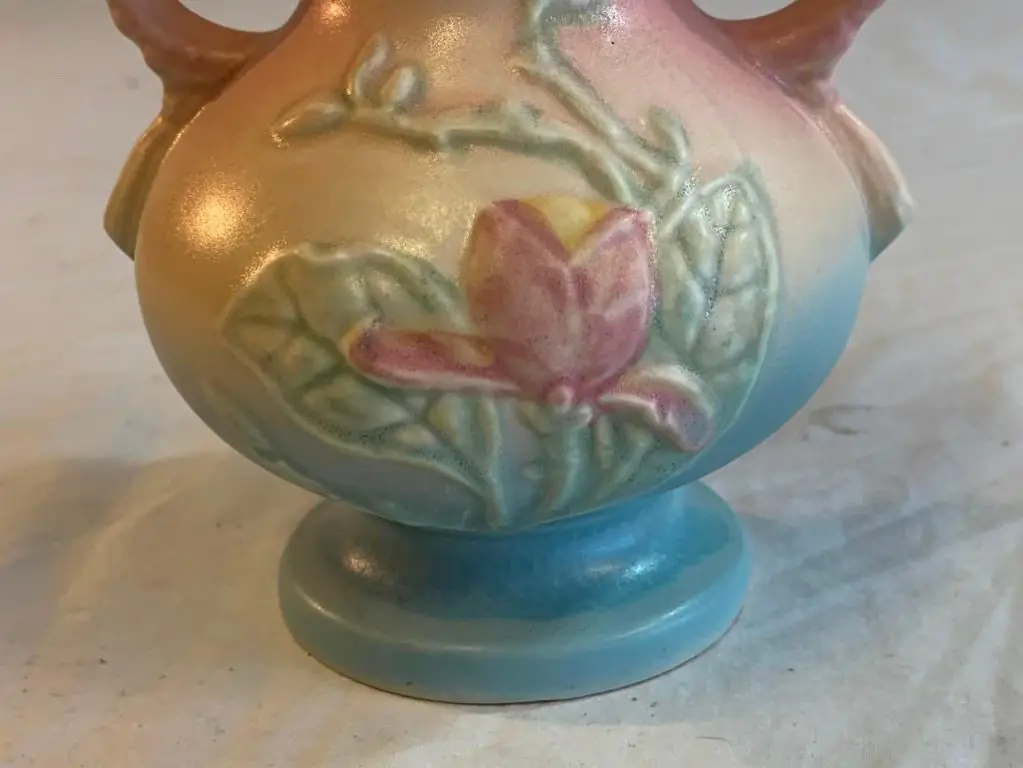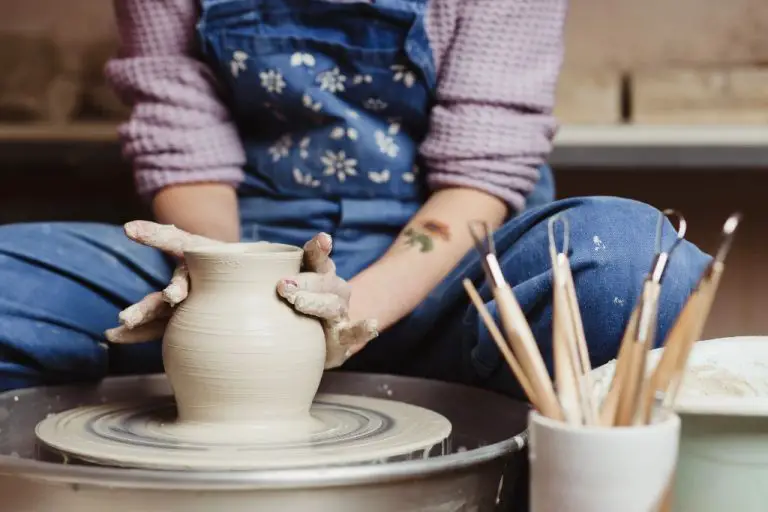Is Hull Pottery Still Made?
Hull Pottery began production in 1905 in Crooksville, Ohio, under the leadership of Addis Emmet (A.E.) Hull. The Hull Pottery Company’s early lines consisted of common brown glazed wares and Rockingham glazes. By 1910, Hull Pottery was producing thirty different lines and was refined into one of the largest potteries in the U.S. [1]
The company’s headquarters, main factory, and showrooms were located in Crooksville, Ohio, about 75 miles southeast of Columbus. At its peak, the Hull factory covered over 14 acres and employed over 500 workers. [2]
In November 1984, the Hull Pottery Company ceased operations after nearly 80 years in business. Increased imports and high overhead costs forced the company into bankruptcy.
Peak Years
According to the Hull Pottery Association, Hull Pottery’s most successful period was from the 1930s through the 1960s Hull Pottery History. During this time, Hull Pottery introduced several popular lines that helped grow the company. One of the most popular was the Little Red Riding Hood line, which included items like cookware, dinnerware, and figurines depicting scenes from the famous fairy tale. This line was very successful during the 1940s-1950s.
Another top seller for Hull Pottery was their Floristware line, consisting of vases and pots with floral motifs Hull pottery. First introduced in the 1940s, the floral shapes and decoration made them ideal for displaying fresh flowers. Floristware remained popular through the 1960s. These key product lines helped make Hull Pottery a household name during their peak era of productivity and popularity.
Closure
Hull Pottery ceased operations and closed the plant in March 1986 after 81 years in business. According to the Hull Pottery Association (http://hullpotteryassociation.org/hull-pottery-history/), several factors contributed to the closure:
- Foreign competition
- Failure to modernize
- Reduction in demand for utilitarian stoneware
- Rising production costs
- Labor issues
The closure was a major blow to the local community in Crooksville, Ohio where Hull Pottery was a major employer. At its peak, the company employed over 300 people. When it closed, Hull Pottery was one of the oldest remaining American potteries producing art pottery and utilitarian stoneware.
Revival Attempts
After Hull Pottery closed in 1986, there have been a few attempts to revive the company and restart production of its iconic dinnerware and pottery. In the early 2000s, Hull Pottery Revival LLC acquired the rights to use the Hull name and designs. They began producing some new pieces using original Hull molds, focusing on art pottery and ovenware items. However, this revival attempt was short-lived and ended after just a couple years.
More recently in 2021, the Hull brand was revived again by American Mug & Stein, which started manufacturing mugs and dinnerware in the classic Hull shapes and patterns. While not an exact recreation of vintage Hull pieces, these new Hull products aim to capture the spirit and aesthetic. It remains to be seen if this latest Hull revival will find lasting success in bringing back a cherished American brand.
Collectibility
Hull Pottery has become highly collectible and valuable among antique and vintage collectors today. This is due to several factors:

Demand for Mid-Century Design – The mid-century modern aesthetic of Hull Pottery has come back into popularity, driving up demand and prices. Its simple, minimalist style fits well with current interior design tastes (Hull Rare for sale).
Nostalgia and Familiar Designs – Baby boomers who grew up with Hull pottery have nostalgia for the classic designs like Little Red Riding Hood and wish to collect pieces from their childhood (Hull Pottery).
Limited Supply – Since production ended in the 1980s, the finite supply of existing Hull Pottery continues to dwindle over time as pieces get lost, broken, etc. This has made remaining pieces more scarce and valuable (Hull Pottery for Sale).
Reputation for Quality – Hull’s innovative glazing techniques and handcrafted artistry have given their pottery a reputation for high quality that collectors still value today.
Identifying Marks
Identifying authentic Hull Pottery can be tricky, mainly because many of their wares are signed as simply ‘USA.’ According to The Spruce Crafts, the earliest Hull marks from around 1910 included a wreath with a number signifying a gallon size and the Hull name. Later marks after 1950 included ‘USA,’ the pattern name, and a shape number.
According to the Hull Pottery Association, when Hull purchased the Acme Pottery Company in 1903, Acme markings included the words ‘The Acme Pottery Company’ surrounded by a wreath. These pieces can be identified as early Hull. The association website provides images of the evolutions of Hull markings over the decades.
Key authentic Hull identifiers include the印’Hull’ name,鈥榮imple ‘USA’ markings,pattern names like鈥榚dgewater,鈥榠ris,鈥� or 鈥榯ulip,鈥� and shape numbers. As noted by a Pinterest guide, fake Hull marks may seem authentic on first glance, so it’s important to inspect them closely.
Notable Artists
Hull Pottery was known for employing talented artists and designers who helped create the company’s unique style and designs. Some of the most notable include:
Charles Murphy – One of Hull’s founding artists, Murphy helped develop innovative glazing techniques like the famous aventurine glazes. He led the art department at Hull for many years and his designs are among the most collectible today (Source).
Viktor Schreckengost – This pioneering industrial designer created some of Hull’s most popular lines like the Jazz Bowl and the famous “banana leaf” pattern. His stylized and flowing designs helped define the Hull aesthetic (Source).
Waylande Gregory – A renowned sculptor, Gregory pushed the boundaries of pottery as art. His famous figural sculptures like “Water Carrier” and his Mask series incorporated influences from various cultures and art movements (Source).
Kenneth Milton – Milton was known for his innovative carved designs and blending of modernist and Art Deco influences. Some of his most popular creations included the “Textured” and “Weave” patterns of the late 1930s (Source).
Current Products
While the original Hull Pottery company closed down decades ago, there are some current products still being made and sold under the Hull Pottery name today. Many of these are reproductions or “new” versions of classic Hull Pottery patterns and designs.
For example, the American Art Clay Co. produces a line of pottery using original Hull molds acquired after the company’s closure. These pieces replicate popular vintage patterns like Blossomtime, Bouquet, and Lazy Dazy in both original and new colors (Amazon). They are stamped with the Hull logo and year produced.
Artist Jeffrey Camp creates handcrafted pottery inspired by Hull, selling artisan mugs, pitchers, bowls, and more through his website. These feature original designs reminiscent of vintage Hull (Etsy).
Various other artists and studios also produce Hull-inspired pieces, incorporating the classic shapes and floral patterns of the original company. While not officially licensed or branded Hull Pottery, these offer consumers new takes on the iconic Hull style (JustArtPottery).
Legacy
Hull Pottery has left behind an impressive legacy despite its relatively short heyday. Founded in 1905, the company quickly rose to prominence and by the 1950s was one of the largest pottery manufacturers in the United States. The detailed Art Deco designs and innovative glazing techniques developed by Hull Pottery influenced many other American ceramic companies. Even though Hull Pottery ceased operations in 1986 after years of declining sales, interest in Hull pottery remains strong among antique collectors and decorative arts enthusiasts today. According to one Etsy seller, “Hull Pottery is highly regarded among pottery collectors for its Art Deco stylings and unique glazes.”
Many museums have added Hull pottery pieces to their decorative arts collections, recognizing the company’s important contributions. Significant public collections can be found at the Metropolitan Museum of Art, the Museum of Fine Arts in Boston, and the Philadelphia Museum of Art. While no longer in production, Hull’s innovative designs and glazes changed the course of American ceramic history and continue to be admired today.
Conclusion
In summary, Hull Pottery is no longer produced today in the original factory and style as its heyday in the early 1900s. The original Hull Pottery company closed down operations in 1984 after struggling financially. There have been some recent revival attempts to reproduce Hull Pottery or acquire the rights to the brand name and designs, but none have successfully brought back full-scale production of authentic Hull Pottery pieces.
While classic Hull Pottery is no longer made, the brand still lives on through a cult following of collectors who seek out vintage pieces to add to their collections. Some modern ceramic artists have also created pieces inspired by the classic Hull Pottery style. So while Hull Pottery itself is a thing of the past, its iconic designs and legacy clearly live on today.
The prospects for a true revival of Hull Pottery production seem low, given the failures of past efforts and the fact that the original molds were destroyed. However, the vibrant collector market suggests that demand remains strong for this quintessentially American pottery style. If the right entrepreneur could obtain licensing for the Hull name and recreate the molds, perhaps Hull Pottery could once again be produced as it was in its heyday. For now, those wishing to own Hull Pottery must turn to antique shops, collectors, and auction sites to find authentic pieces from the early 20th century.



